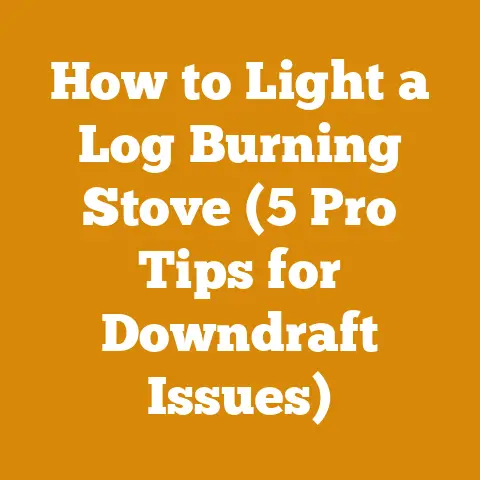Wall Mount Pellet Stove Review (Installation Tips & Wood Fuel Insights)
Ever feel like your home heating options are as limited as a squirrel’s winter stash? Then you’ve probably pondered the idea of a pellet stove. But what if floor space is at a premium? Enter the wall mount pellet stove. This review delves deep into the world of these space-saving heaters, offering installation tips and crucial insights into wood fuel, all while sharing my own experiences with wood processing and the challenges of efficient home heating.
Wall Mount Pellet Stove Review: Installation Tips & Wood Fuel Insights
As someone who’s spent countless hours splitting logs, wrestling with chainsaws, and optimizing wood-burning efficiency, I understand the allure of a good, clean heat source. Pellet stoves offer a modern twist on traditional wood burning, and the wall-mounted variety adds a unique dimension. Let’s unpack everything you need to know.
What is a Wall Mount Pellet Stove?
A wall mount pellet stove, as the name suggests, is a heating appliance designed to be mounted on a wall rather than sitting on the floor. It burns compressed wood or biomass pellets to generate heat. These stoves are typically smaller and more compact than their freestanding counterparts, making them ideal for smaller spaces, apartments, or homes where floor space is limited.
Key Benefits:
- Space Saving: The primary advantage, obviously. Frees up valuable floor area.
- Modern Aesthetics: Many models boast sleek, contemporary designs that can enhance a room’s decor.
- Zone Heating: Effectively heat a specific area of your home without needing to crank up the central heating system.
- Ease of Use: Pellet stoves are generally easy to operate, with automated feeding systems and programmable thermostats.
- Eco-Friendly: Burning wood pellets is often considered a carbon-neutral heating option, especially when sourced sustainably.
Why Choose a Wall Mount Over a Freestanding Pellet Stove?
The choice between a wall mount and a freestanding pellet stove boils down to your specific needs and circumstances. Here’s a breakdown:
| Feature | Wall Mount Pellet Stove | Freestanding Pellet Stove |
|---|---|---|
| Space Efficiency | Excellent. Ideal for small rooms, apartments, or homes where floor space is limited. | Less space-efficient. Requires dedicated floor space. |
| Aesthetics | Modern, sleek designs. Can blend seamlessly into contemporary interiors. | Can range from traditional to modern styles. Often a focal point in a room. |
| Heat Output | Generally lower heat output compared to larger freestanding models. Suitable for heating smaller areas. | Higher heat output. Can heat larger spaces or even entire homes, depending on the BTU rating. |
| Installation | Can be more complex due to wall mounting requirements. Requires careful consideration of wall structure and clearances. | Simpler installation, typically requiring a hearth pad and venting. |
| Portability | Not portable. Once installed, it’s intended to be a permanent fixture. | Semi-portable. Can be moved, but requires disconnecting and reinstalling the venting. |
| Cost | Can be comparable in price to smaller freestanding models, but installation costs may be higher. | Prices vary widely depending on size, features, and BTU rating. |
My Take: I’ve seen firsthand how a well-placed wall mount pellet stove can transform a cramped space. One of my neighbors, living in a small cabin, opted for a wall mount model and was amazed at how much room it freed up while still providing adequate heat during those harsh winter months.
Key Features to Consider When Choosing a Wall Mount Pellet Stove
Before you dive into the market, it’s crucial to understand the features that will impact your stove’s performance and your overall satisfaction.
- BTU Rating (British Thermal Units): This measures the heat output of the stove. A higher BTU rating means more heat. Match the BTU rating to the size of the area you want to heat. A general rule of thumb is 5,000 BTU per 200 square feet in a moderately insulated space.
- Hopper Capacity: The hopper is where you load the pellets. A larger hopper means less frequent refilling. Consider your usage patterns and how often you want to add pellets.
- Efficiency Rating: This indicates how efficiently the stove converts fuel into heat. Look for stoves with higher efficiency ratings to save on fuel costs. Efficiency ratings above 80% are generally considered good.
- Thermostat Control: A programmable thermostat allows you to set specific temperatures and schedules, optimizing comfort and fuel consumption.
- Ignition System: Automatic ignition systems are convenient and eliminate the need for manual lighting.
- Safety Features: Look for features like overheat protection, automatic shut-off, and safety certifications (e.g., UL, CSA).
- Warranty: A good warranty provides peace of mind and protects you against potential defects.
- Air Wash System: Keeps the glass door clean, allowing you to enjoy the flame.
- Ash Pan: A removable ash pan simplifies cleaning.
- Noise Level: Pellet stoves can generate some noise from the auger and blower fan. Consider the noise level, especially if you’re sensitive to sound.
- Design and Aesthetics: Choose a stove that complements your home’s decor.
Top Wall Mount Pellet Stove Models (2024)
While specific models are constantly evolving, here are a few brands and types of wall mount pellet stoves that consistently receive positive reviews and are worth considering:
- Comfortbilt: Known for their reliable performance and user-friendly features.
- Castle Serenity: Offers a compact design and efficient heating.
- Piazzetta: (Typically freestanding, but some smaller models can be wall-mounted with appropriate brackets. Check manufacturer specifications.) Renowned for their high quality and stylish designs.
- Eco-6500: This is a popular option for those looking for a high BTU output in a wall mountable unit.
Note: Always check the manufacturer’s specifications and local building codes before purchasing and installing any pellet stove.
Installation Tips for Wall Mount Pellet Stoves
Installing a wall mount pellet stove is a more complex process than simply plugging in an appliance. It requires careful planning, adherence to safety regulations, and often, professional assistance.
-
Planning and Preparation:
- Location: Choose a location that meets the manufacturer’s clearance requirements for combustible materials. Ensure the wall is strong enough to support the weight of the stove (consult a structural engineer if necessary).
- Venting: Plan the venting system carefully. Pellet stoves require venting to the outside to exhaust combustion gases. Follow the manufacturer’s instructions for vent pipe diameter, length, and termination. Consider whether you need a horizontal or vertical vent run.
- Electrical: Ensure you have a dedicated electrical circuit with the appropriate amperage for the stove.
- Permits: Check with your local building department for any required permits or inspections.
-
Mounting the Stove:
-
Wall Brackets: Use heavy-duty wall brackets specifically designed for pellet stoves. Ensure they are securely anchored to the wall studs.
- Leveling: Use a level to ensure the stove is mounted perfectly level. This is crucial for proper operation and safety.
-
Venting Installation:
-
Type of Venting: Use only venting components specifically designed for pellet stoves. These are typically made of stainless steel and are designed to withstand high temperatures and corrosive gases.
- Sealing: Seal all vent pipe connections with high-temperature silicone sealant.
- Clearances: Maintain proper clearances between the vent pipe and combustible materials.
- Termination: Ensure the vent termination is located in a safe area away from windows, doors, and air intakes.
-
Electrical Connections:
-
Grounding: Ensure the stove is properly grounded.
- Circuit Breaker: Use a dedicated circuit breaker for the stove.
-
Testing and Calibration:
-
Initial Burn: Perform an initial burn to check for leaks and ensure the stove is operating properly.
- Calibration: Calibrate the thermostat according to the manufacturer’s instructions.
DIY vs. Professional Installation:
While some experienced DIYers may be comfortable installing a wall mount pellet stove, I strongly recommend professional installation, especially if you’re not familiar with electrical work, venting systems, and building codes. Incorrect installation can lead to safety hazards, such as carbon monoxide poisoning or fire.
Cost of Installation:
The cost of professional installation can vary depending on the complexity of the installation, the location of the stove, and local labor rates. Expect to pay anywhere from \$500 to \$1500 for professional installation.
Wood Fuel Insights: Choosing the Right Pellets
The type of pellets you use can significantly impact your stove’s performance, efficiency, and longevity.
-
Types of Pellets:
- Hardwood Pellets: Made from hardwoods like oak, maple, and birch. They typically produce more heat and burn cleaner than softwood pellets.
- Softwood Pellets: Made from softwoods like pine and fir. They tend to be less expensive than hardwood pellets but may produce more ash.
- Mixed Pellets: A blend of hardwood and softwood.
- Premium vs. Standard Pellets: Premium pellets have lower ash content and higher BTU ratings than standard pellets.
-
Pellet Quality:
- Ash Content: Look for pellets with low ash content (less than 1%). High ash content can clog the stove and require more frequent cleaning.
- BTU Rating: Choose pellets with a high BTU rating for maximum heat output.
- Moisture Content: Pellets should have low moisture content (less than 8%). High moisture content reduces efficiency and can cause the stove to smoke.
- Consistency: Pellets should be consistent in size and shape for smooth feeding.
-
Storage:
- Store pellets in a dry, protected area to prevent them from absorbing moisture.
- Avoid storing pellets directly on the ground. Use a pallet or raised platform.
My Experience: I once purchased a batch of cheap pellets that turned out to be of poor quality. They produced excessive ash, clogged my stove, and significantly reduced its heating efficiency. I learned my lesson and now only buy high-quality pellets from reputable suppliers.
Data Point: According to the Pellet Fuels Institute (PFI), premium pellets should have an ash content of less than 1%, a BTU rating of at least 8,000 BTU/lb, and a moisture content of less than 8%.
Maintaining Your Wall Mount Pellet Stove
Regular maintenance is essential for keeping your pellet stove running efficiently and safely.
-
Daily:
- Empty the ash pan.
- Clean the glass door.
-
Weekly:
- Vacuum the firebox and heat exchanger tubes.
- Inspect the venting system for obstructions.
-
Monthly:
- Clean the burn pot.
- Inspect the auger system.
-
Annually:
- Have the stove professionally inspected and cleaned.
- Inspect the venting system for damage and corrosion.
Safety First: Always disconnect the stove from the power supply before performing any maintenance.
Troubleshooting Common Pellet Stove Problems
Even with regular maintenance, you may encounter some common pellet stove problems. Here are a few troubleshooting tips:
-
Stove Won’t Ignite:
- Check the hopper for pellets.
- Ensure the igniter is working.
- Clean the burn pot.
-
Stove Produces Smoke:
- Check the venting system for obstructions.
- Ensure the pellets are dry.
- Clean the stove thoroughly.
-
Stove Overheats:
- Check the air intake for obstructions.
- Ensure the blower fan is working properly.
- Reduce the feed rate.
-
Stove Makes Excessive Noise:
- Check the auger system for obstructions.
- Lubricate the auger motor.
- Tighten any loose screws or bolts.
When to Call a Professional: If you’re unable to resolve a problem yourself, it’s best to call a qualified technician.
Cost Considerations: Is a Wall Mount Pellet Stove Economical?
The cost of owning and operating a wall mount pellet stove includes the initial purchase price, installation costs, fuel costs, and maintenance costs.
- Purchase Price: Wall mount pellet stoves typically range in price from \$1,500 to \$4,000, depending on the size, features, and brand.
- Installation Costs: Professional installation can cost anywhere from \$500 to \$1500.
- Fuel Costs: Pellet prices vary depending on location and demand. On average, a ton of pellets costs between \$250 and \$400. A typical homeowner may use 2-4 tons of pellets per heating season.
- Maintenance Costs: Annual maintenance costs can range from \$100 to \$300.
Cost-Effectiveness:
Whether a wall mount pellet stove is economical depends on several factors, including:
- The cost of alternative heating options: Compare the cost of heating with electricity, natural gas, or oil.
- Your heating needs: If you only need to heat a small area, a pellet stove can be more cost-effective than heating your entire home with central heating.
- Your climate: In colder climates, you’ll likely use more pellets, increasing your fuel costs.
- Pellet prices: Shop around for the best pellet prices in your area.
Data Point: According to the U.S. Energy Information Administration (EIA), the average cost of heating with natural gas is \$10.73 per thousand cubic feet, while the average cost of heating with electricity is \$0.14 per kilowatt-hour. Compare these costs to the cost of heating with pellets to determine which option is most economical for you.
The Environmental Impact of Pellet Stoves
Burning wood pellets is often considered a carbon-neutral heating option because the carbon dioxide released during combustion is offset by the carbon dioxide absorbed by the trees during their growth. However, the environmental impact of pellet stoves depends on several factors:
- Sustainable Sourcing: Ensure the pellets are sourced from sustainably managed forests.
- Stove Efficiency: Choose a stove with a high efficiency rating to minimize emissions.
- Pellet Quality: Use high-quality pellets with low ash content to reduce emissions.
- Proper Maintenance: Regular maintenance helps to ensure the stove is operating efficiently and cleanly.
Concerns:
- Particulate Matter: Pellet stoves can emit particulate matter, which can contribute to air pollution. However, newer stoves with advanced combustion technologies produce significantly lower emissions than older models.
- Deforestation: If pellets are not sourced sustainably, they can contribute to deforestation.
My Perspective: I’m a strong advocate for responsible forestry practices. When I harvest wood for firewood, I always ensure that I’m doing so sustainably, selecting trees that are diseased or overcrowded and leaving the healthiest trees to continue growing.
Wall Mount Pellet Stoves: A Sustainable Heating Solution?
While pellet stoves are often touted as a sustainable heating solution, it’s crucial to consider the entire lifecycle of the fuel, from forest management to combustion emissions.
- Sustainable Forestry: Look for pellets certified by organizations like the Sustainable Forestry Initiative (SFI) or the Forest Stewardship Council (FSC). These certifications ensure that the pellets are sourced from sustainably managed forests.
- Efficient Stoves: Choose a pellet stove with a high efficiency rating and low emissions. Look for stoves that are certified by the Environmental Protection Agency (EPA).
- Proper Maintenance: Regular maintenance helps to ensure the stove is operating efficiently and cleanly, minimizing emissions.
The Future of Pellet Stoves:
The pellet stove industry is constantly evolving, with manufacturers developing more efficient and cleaner-burning stoves. Emerging technologies, such as advanced combustion systems and catalytic converters, are helping to reduce emissions and improve air quality.
Real-World Case Studies
To illustrate the practical application of wall mount pellet stoves, let’s examine a few real-world case studies:
-
Case Study 1: Small Apartment Heating:
- Problem: A resident of a small apartment in a city with cold winters was looking for a space-saving and cost-effective heating solution.
- Solution: A wall mount pellet stove was installed in the living room. The stove provided supplemental heat, reducing the reliance on the building’s central heating system.
- Results: The resident saved money on heating costs and enjoyed a more comfortable living environment. The wall mount design freed up valuable floor space.
- Equipment Used: Comfortbilt wall mount pellet stove.
- Wood Type: Premium hardwood pellets.
- Safety Considerations: Professional installation ensured proper venting and electrical connections.
-
Case Study 2: Cabin Heating in a Rural Area:
- Problem: A homeowner with a small cabin in a rural area wanted a reliable and independent heating source.
- Solution: A wall mount pellet stove was installed in the main living area. The stove provided a backup heating source in case of power outages.
- Results: The homeowner had peace of mind knowing they had a reliable heating source. The pellet stove was easy to operate and maintain.
- Equipment Used: Castle Serenity wall mount pellet stove.
- Wood Type: Mixed hardwood and softwood pellets.
- Safety Considerations: Regular maintenance and inspection of the venting system.
-
Case Study 3: Supplemental Heating in a Home Office:
- Problem: A homeowner who worked from home wanted to heat their home office without heating the entire house.
- Solution: A wall mount pellet stove was installed in the home office. The stove provided targeted heating, reducing energy consumption.
- Results: The homeowner saved money on heating costs and enjoyed a comfortable work environment.
- Equipment Used: Eco-6500 wall mount pellet stove.
- Wood Type: Premium softwood pellets.
- Safety Considerations: Proper clearances from combustible materials.
Actionable Takeaways for Choosing and Using a Wall Mount Pellet Stove
- Assess Your Needs: Determine your heating needs, space constraints, and budget.
- Research Models: Compare different wall mount pellet stove models based on BTU rating, efficiency, features, and price.
- Consider Installation: Factor in the cost of professional installation and ensure you meet all local building codes.
- Choose Quality Pellets: Select high-quality pellets with low ash content and high BTU ratings.
- Maintain Regularly: Perform regular maintenance to keep your stove running efficiently and safely.
- Prioritize Safety: Always prioritize safety when installing and operating your pellet stove.
Final Thoughts: Is a Wall Mount Pellet Stove Right for You?
Wall mount pellet stoves offer a compelling combination of space-saving design, modern aesthetics, and efficient heating. They are an excellent option for homeowners looking to supplement their existing heating system, heat smaller spaces, or create a cozy ambiance. By carefully considering your needs, researching your options, and prioritizing safety, you can enjoy the benefits of a wall mount pellet stove for years to come.
Remember, the key to success with any wood-burning appliance, including a pellet stove, lies in understanding the nuances of wood fuel, mastering proper maintenance techniques, and always prioritizing safety. Now, go forth and conquer those heating bills!






